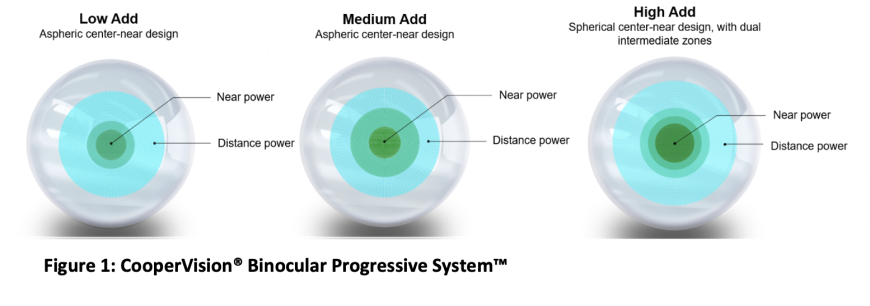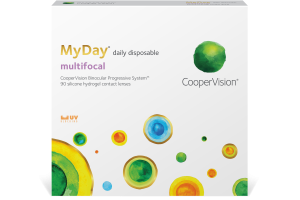On a global scale, it’s projected that about 2.1 billion people will have presbyopia by 2030 and with the aging population, this number will continue to increase further over the next few years.1 Contact lens prescribing trends from 2023 reflect the different approaches eye care professionals take when fitting presbyopes with soft contact lenses.2 Globally, slightly more than half of patients over 45 years of age were fitted with multifocal contact lenses and 8% with monovision.2
Once a presbyope has been fit with contact lenses, regular follow-up visits are critical to ensure success. A recent review on reasons for contact lens drop out highlighted that new wearers of single vision lenses may discontinue due to issues with lens handling and discomfort, while those fit in torics and multifocal contact lenses struggle more with poor vision.3 It should also be recognized that aging is a significant risk factor for dryness symptoms which affect more women than men,4 and these signs and symptoms need to be monitored and managed appropriately. To manage visual needs, attention needs to be paid to distance, intermediate and near vision with today’s digital lifestyle having increased visual demands at all distances.
Factors for Multifocal Contact Lens Success
Fitting optimal multifocal contact lenses will look different for each patient with presbyopia in practice, with decisions on lens type, material and replacement schedule influenced by lens wear history, ocular physiology, lifestyle and expectations. Concerns often raised by eye care professionals previously have been that multifocal contact lenses should cover a wide prescription range and be easy to fit to help minimize chair time.5
Today’s soft multifocal contact lenses are available in a range of lens designs, with center near or distance optics, although with differences between manufacturers and lens brands, this variation combined with patient factors has meant eye care professionals can find multifocal contact lenses fit success difficult to predict.6 This level of uncertainty and unpredictability may be one of the reasons only 15% of new soft lens fits and refits globally were with multifocal contact lenses in 2023.2 A simple to fit, predictably comfortable multifocal contact lens that delivers good vision at all distances would boost ECP confidence in fitting and help to reduce lapsing by meeting patient needs.
Daily disposable multifocal contact lenses offer the best flexibility in wear schedules. These not only eliminate the need for lens cases, care regimens and the associated lens handling, but they are also associated with reduced risks of ocular complications.7,8 Daily disposable contact lens wear fits a flexible lifestyle and is particularly popular with part-time wearers, who wear their lenses 1-3 times per week, compared to just 20% of frequent replacement lens wearers who wear only part-time.9
This article introduces innovations in daily multifocal contact lenses that have been designed to meet the needs of eye care professionals and their patients with presbyopia.
Introducing clariti® 1 day multifocal 3 Add

CooperVision recently launched its latest innovation in multifocals: clariti® 1 day multifocal 3 Add with Binocular Progressive SystemTM10 that helps provide optimal visual acuity at all distances and for all levels of presbyopia even as a patient’s vision changes.11
clariti® 1 day multifocal 3 Add provides excellent initial comfort on dispensing12 and features the Optimized Comfort Edge™ design that helps provide a high level of comfort after 1 week of daily wear13 and WetLoc® Technology that supports good all-day comfort.* Wetloc® Technology locks in water molecules that are evenly distributed throughout the entire lens matrix mimicking the moisture dispersion of naturally healthy eyes.
Additionally, the new 3 Add design offers an expanded parameter range, allowing ECPs to fit even more patients with presbyopia.14 Sphere powers are available in +8.00D to -10.00D in 0.25D steps, and -10.50D to -12.00D in 0.50D steps.14 Add powers are available in Low (+0.75D to +1.25D), Medium (+1.50D to +1.75D) and High (+2.00D to +2.50D. The expanded parameters in the clariti® 1 day multifocal 3 Add represent the widest range vs. other competitor 1-day multifocals, allowing more patients to experience the new lens at an affordable price.10,14
Of note, a majority of patients refit from the original design to the 3 Add cited improved vision,†15 high satisfaction with the lenses’ comfort,‡15 and good overall lens-wearing satisfaction.‡15
MyDay® daily disposable multifocal

Another part of CooperVision’s 1 day multifocal portfolio is MyDay® multifocal, which like the clariti 1 day family, also offers spherical and toric designs. MyDay lenses use Aquaform® Technology with the stenfilcon A silicone hydrogel material; this binds water throughout the lens material to help retain moisture.16 MyDay multifocal covers a wide range of distance spherical powers (+8.00 to -12.00DS), with 0.25D steps in most powers for prescribing accuracy, along with three add powers.
For presbyopes with astigmatism of up to 0.75DC, the range covers 99.8% of prescriptions.17
A Closer Look at CooperVision Binocular Progressive System®
Found in both clariti 1 day multifocal 3 Add and MyDay multifocal is CooperVision Binocular Progressive System®, an innovative design that helps patients with presbyopia achieve their vision needs with its unique 3 Add system.11,18
The Binocular Progressive System allows the multifocal designs to work in tandem, with a simple fitting process19,20 and easy progression for patients with presbyopia as the near vision requirement increases.11,19 The Low and Medium Add lenses have an aspheric center‐near design with a wide distance area and optical progression into the central reading area, and cover spectacle adds from +0.75 to +1.25D for the Low Add, and from +1.50 to +1.75D for the Medium Add.11,18 The High Add lens, which is used with later stage patients with presbyopia, has been designed with a single‐powered, spherical center‐near zone and spherical dual intermediate power zones to address intermediate and near vision needs (Figure 1).11,18

Lens Fitting – Simple and Successful
Ease of fit saves time for patients on repeat visits, and it is particularly important for busy eye care professionals who would like a multifocal contact lens to work well the first time. The Binocular Progressive System fitting guide for clariti 1 day multifocal 3 Add and MyDay multifocal was developed through a series of clinical trials and validated in a randomized, controlled, clinical study, and is crucial to provide a fast and successful fit. So, it is strongly recommended to follow the steps described to increase success and help minimize chair time.
In fact, at least, 83% of wearers achieve their final prescription with the initial pair of lenses,19,21 and at least 98% of patients are successfully fit with no more than two pairs.18,19,21
Here are some tips to get you started:
Start with an up-to-date refraction, ensure the presbyope is not over-minused, and determine ocular dominance using the +1.00 blur method. The guide always directs the Low Add to the dominant eye, while the non-dominant eye receives either Low, Medium or High Add based on the near addition. After asking patients to experience the lenses in a “real world” environment, vision assessment at all distances should be binocular under normal room illumination.
For vision enhancement, the distance prescription needs to be adjusted either to the dominant eye for distance improvement, or non-dominant for near vision (±0.25D) using a hand-held lens or flipper. Always keep in mind that the initial near add selection (Low, Medium or High) will remain unchanged.
Turn to OptiExpert™ – for Extra Fitting Support
Another tool is available that supports CooperVision soft lens fitting even before the first lens is placed on eye. The OptiExpert™ app has been developed to help with the initial lens selection for all CooperVision soft lens products including clariti 1 day multifocal 3 Add and MyDay multifocal. Simply enter the up-to-date subjective refraction and vertex distance in the OptiExpert fitting app, and it will suggest the prescription for all lens options available for this specific patient.
This tool could be used by optometric assistants to start the first conversation about multifocal contact lens options before the patient sits in the chair, and trial lenses can be prepared in advance. This means other practice personnel can be involved in the contact lens patient education and management process and may help reduce chair time.
Find out more about clariti 1 day multifocal 3 add and MyDay multifocal for your patients with presbyopia. You can also learn more multifocal fitting success tips and discover further readings on CooperVision technologies at CooperVision’s Online Success Center.
*Manufacturer's quoted core water content.
†Distance logMAR VA -0.05 vs -0.02 (p < 0.01), near VA 0.06 vs 0.11 (p = 0.02) for BPS vs 2 ADD respectively.
‡Subject rating on a typical day at 2-week visit.
References:
1. Fricke TR, Tahhan N, Resnikoff S, et al. Global Prevalence of Presbyopia and Vision Impairment from Uncorrected Presbyopia: Systematic Review, Meta-analysis, and Modelling. Ophthalmology. Oct 2018;125(10):1492-1499).
2. Nichols JJ, et al. International Contact Lens Prescribing in 2023. Contact Lens Spectrum. Jan. 1, 2024. https://clspectrum.com/issues/2024/januaryfebruary/international-contact-lens-prescribing-in-2023/
3. Pucker, A.D. and A.A. Tichenor, A Review of Contact Lens Dropout. Clin Optom (Auckl), 2020. 12: p. 85-94.
4. de Paiva, C.S., Effects of Aging in Dry Eye. Int Ophthalmol Clin, 2017. 57(2): p. 47-64.
5. Thite, N., et al., Barriers, motivators and enablers for dispensing multifocal contact lenses in Mumbai, India. J Optom, 2015. 8(1): p. 56-61.
6. Perez-Prados, R., et al., Soft multifocal simultaneous image contact lenses: a review. Clin Exp Optom, 2017. 100(2): p. 107-127.
7. Steele, K.R. and L. Szczotka-Flynn, Epidemiology of contact lens-induced infiltrates: an updated review. Clin Exp Optom, 2017. 100(5): p. 473-481.
8. Sulley, A. and K. Dumbleton, Silicone hydrogel daily disposable benefits: The evidence. Cont Lens Anterior Eye, 2020. 43(3): p. 298-307.
9. Morgan, P.B. and N. Efron, Quarter of a century of contact lens prescribing trends in the United Kingdom (1996 - 2020). Cont Lens Anterior Eye, 2021: p. 101446.
10. CVI data on file, 2022.
11. CVI data on file 2021. Prospective, double-masked, bilateral, one-week dispensing study with clariti® 1 day multifocal 3 add; with ratings from 85 to 89 out of 100; n=90 habitual MFCL wearers.
12. CVI data on file 2021. Prospective, double-masked, bilateral, one-week dispensing study with clariti® 1 day multifocal 3 add; with a rating of 93 out of 100; n=90 habitual MFCL wearers.
13. CVI data on file 2021. Prospective, double-masked, bilateral, one-week dispensing study with clariti® 1 day multifocal 3 add with a rating of 88 out of 100; n=90 habitual MFCL wearers.
14. CVI data on file 2024. Based on prescription option combinations (sph and add) available across all daily disposable multifocal soft lenses from CVI, JJV, B+L and Alcon in USA Feb 2024.
15. CVI data on file, 2022. Prospective, crossover, bilateral, subject masked, daily wear, dispensing study (4 clinical sites in U.S.) (n=58 habitual soft MFCL wearers).
16. CVI data on file, 2024.
17. CVI data on file 2021 & 2024; Rx coverage database n=72,937; 42 to 70 years.
18. CVI data on file 2020. Prospective, double-masked, bilateral, one-week dispensing study UK with MyDay® multifocal; n=104 habitual multifocal contact lens wearers.
19. CVI data on file 2021. Prospective, double-masked, bilateral, one-week dispensing study with clariti® 1 day multifocal 3 add; n=90 habitual MFCL wearers.
20. McParland M, Walsh K, Comoroda D, Sulley A. Wearer Experience and Eye Care Professional Acceptance with a 1 Day Multifocal Contact Lens. Clin Optom (Auckl). 2022 Nov 22;14:223-235.
21. CVI data on file 2021. Prospective, subject-masked, randomized, bilateral, two-week dispensing study at 5 US sites with MyDay® multifocal; n=58 habitual multifocal contact lens wearers.








